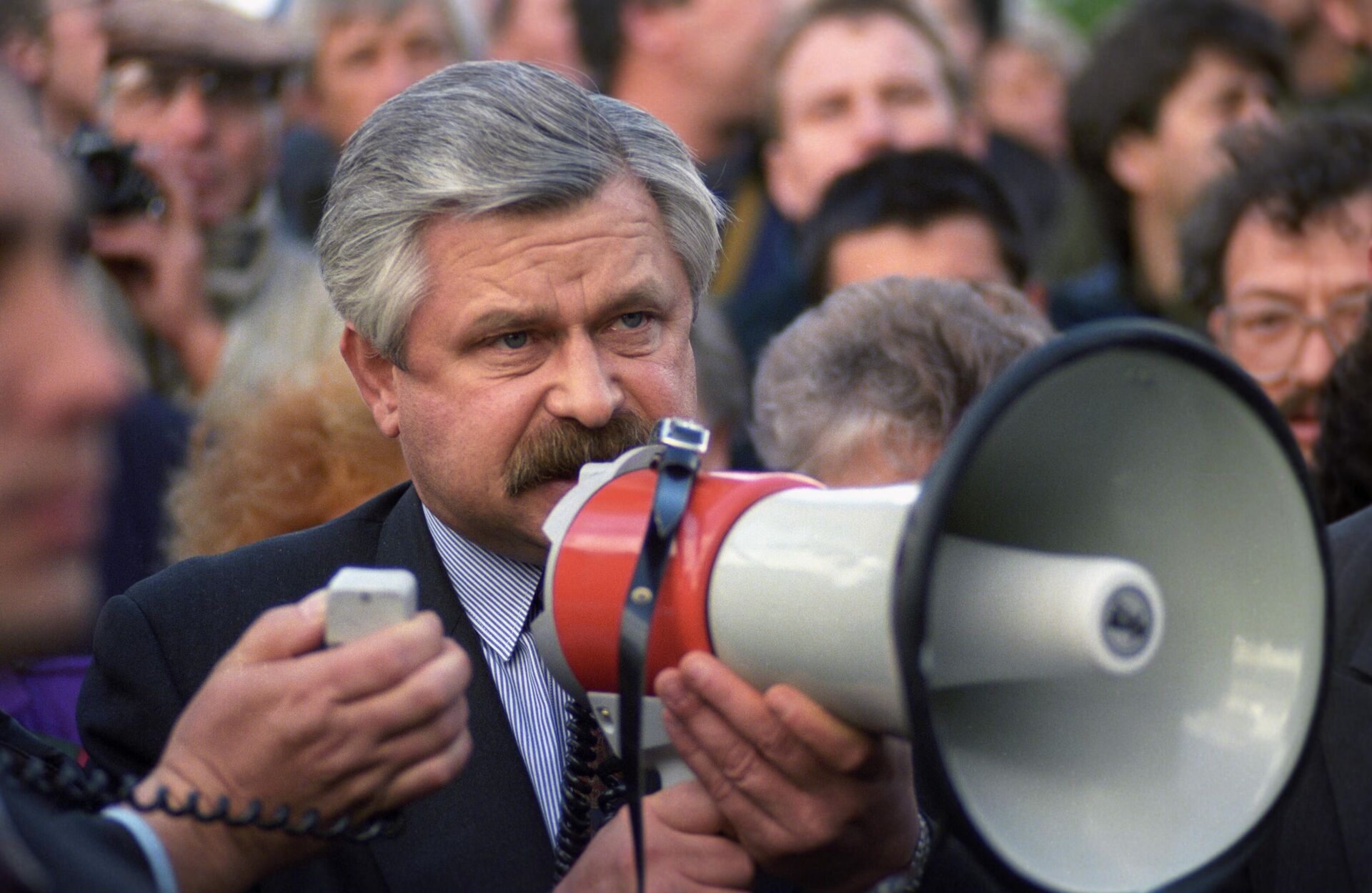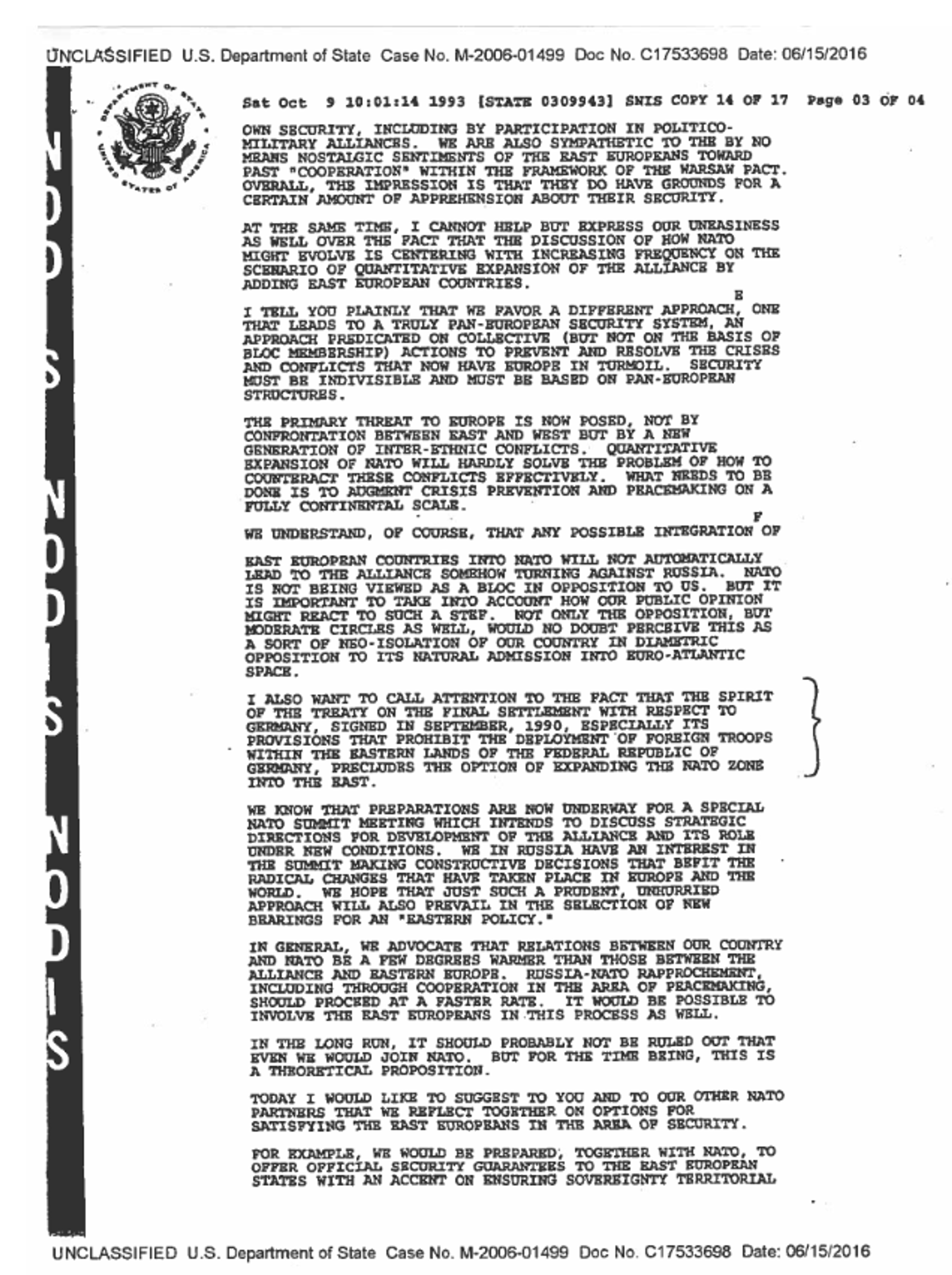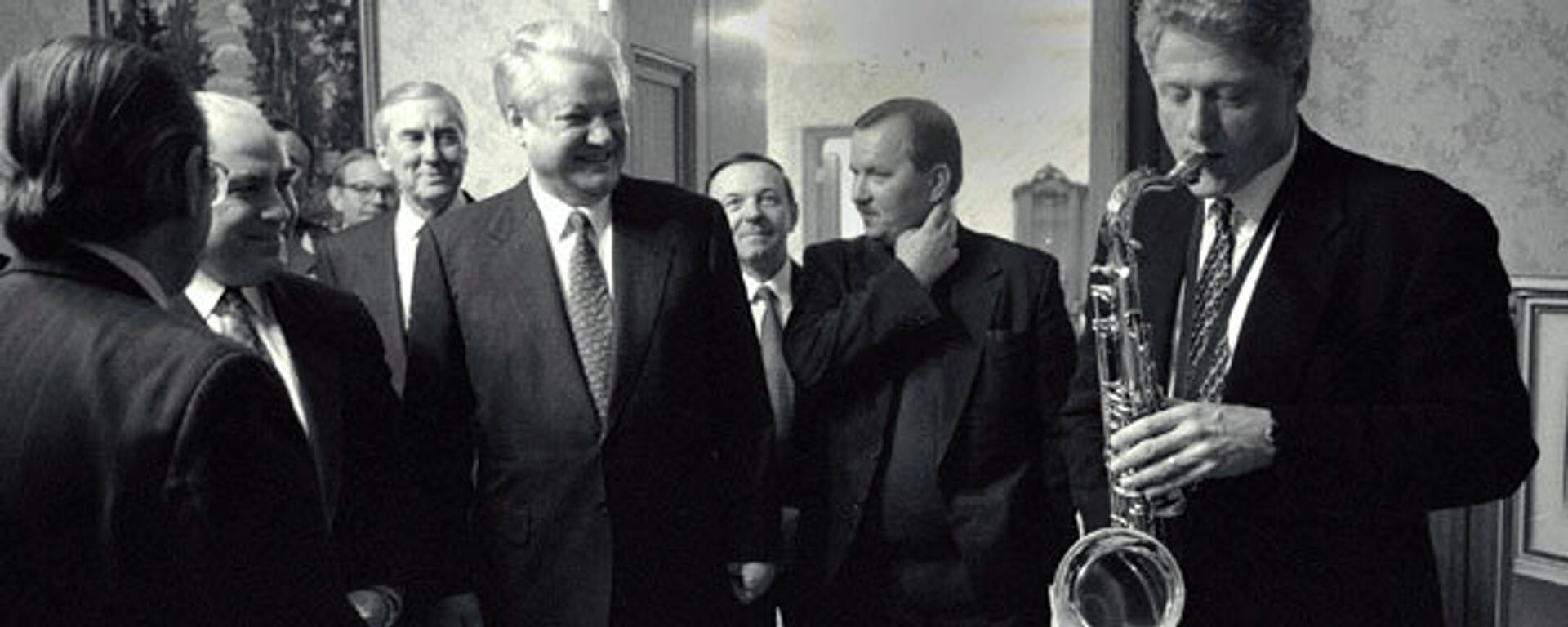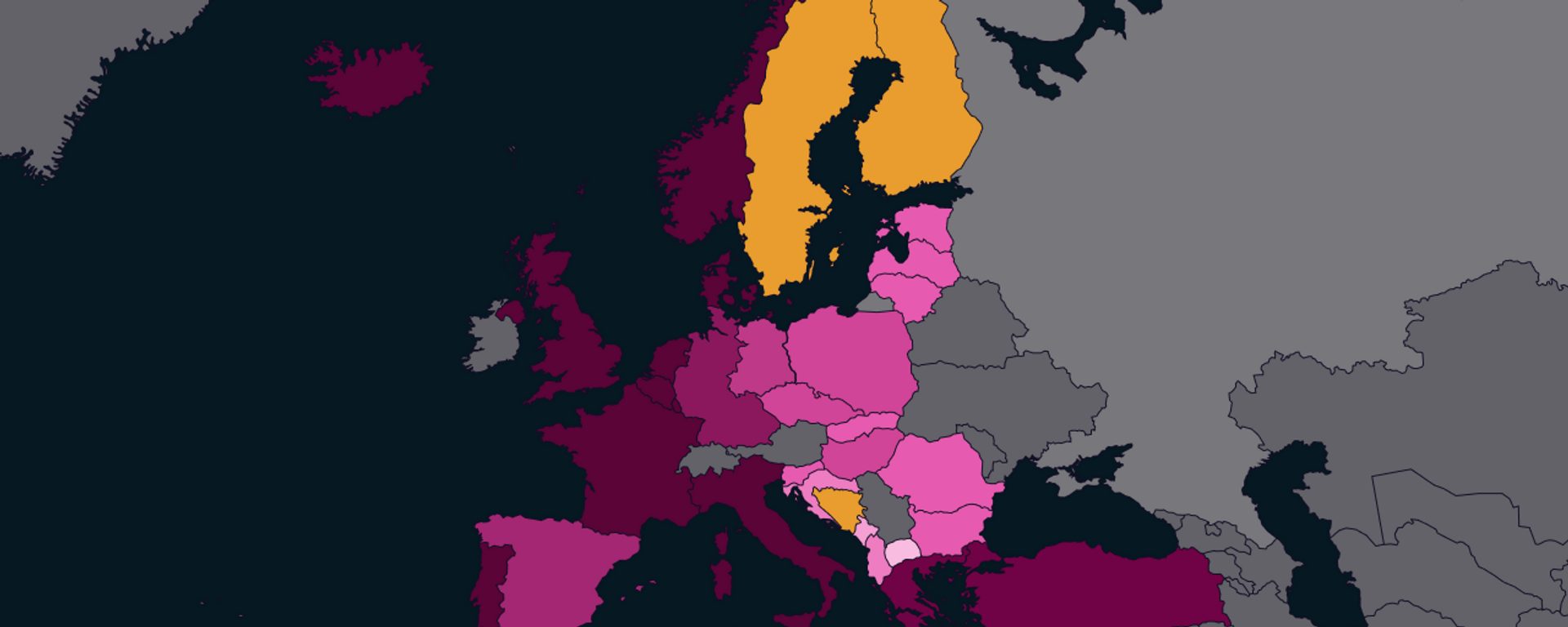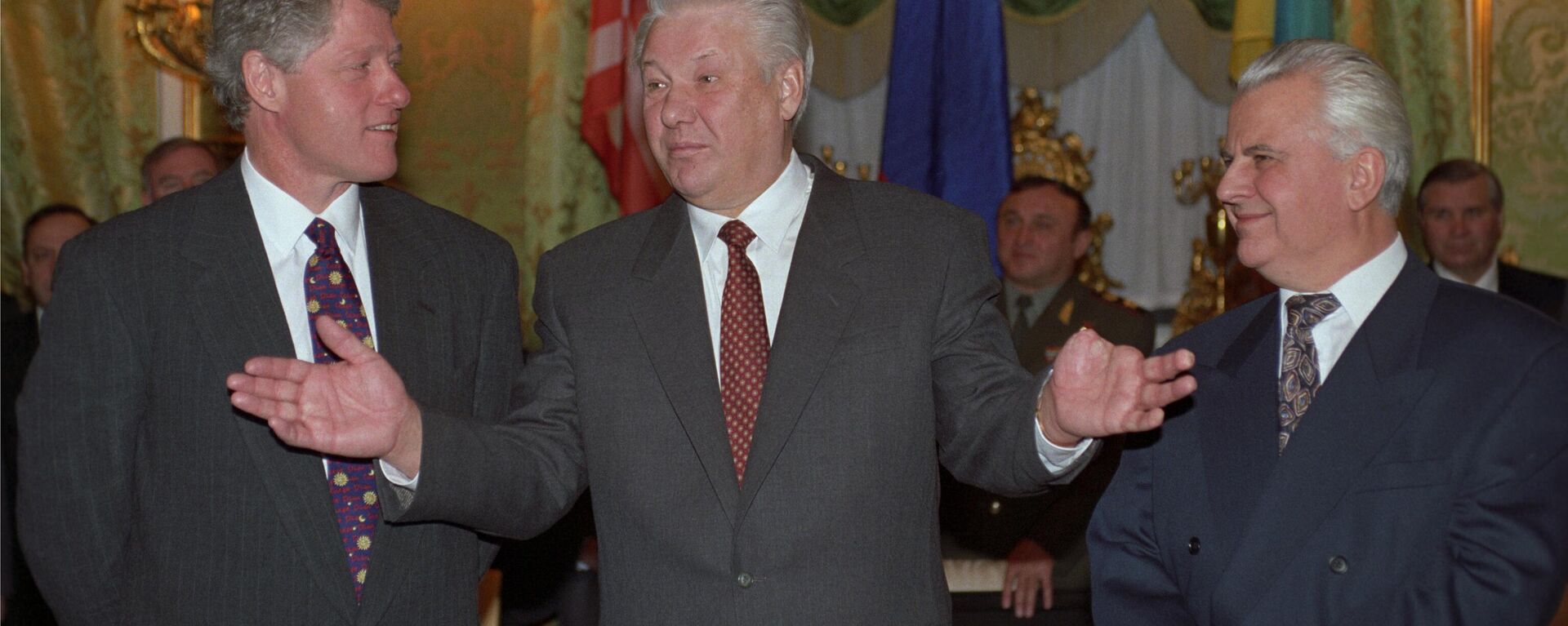https://sputnikglobe.com/20231003/how-clinton-used-russias-1993-crisis-to-dupe-yeltsin-on-natos-eastward-march-1113895633.html
How Clinton Used Russia’s 1993 Crisis to Dupe Yeltsin on NATO’s Eastward March
How Clinton Used Russia’s 1993 Crisis to Dupe Yeltsin on NATO’s Eastward March
Sputnik International
This week marks the 30th anniversary of the bloody finale to the 1993 Russian Constitutional Crisis – which saw the streets of Moscow turned into a... 03.10.2023, Sputnik International
2023-10-03T19:01+0000
2023-10-03T19:01+0000
2023-10-03T19:33+0000
russia
moscow
washington
boris yeltsin
nato
kremlin
white house
russia
https://cdn1.img.sputnikglobe.com/img/106854/57/1068545720_0:149:3114:1901_1920x0_80_0_0_56e686bd0abf4592503f18414f09d050.jpg
In the early morning hours of October 4, 1993, Russian security forces loyal to President Boris Yeltsin surrounded the Russian parliament building – where Vice President Alexander Rutskoy, parliamentary chairman Ruslan Khasbulatov, hundreds of rebellious Supreme Soviet lawmakers, and ordinary citizens opposed to the Yeltsin government and its political and economic reform agenda were holed up. Pro-Yeltsin forces made preparations to storm the building after the brewing constitutional crisis turned violent on the night of October 3, as supporters of the Supreme Soviet made an attempt to take over the Ostankino Television Center.At 7 am, flares were lit, signaling the start of an operation to storm the building and smoke lawmakers out, with armored personnel carriers ramming through makeshift barricades along the Krasnopresnenskaya Embankment, and tanks rumbling down Kutuzovsky Prospect, positioning themselves on Novoarbatsky Bridge and firing into the building, as Army and special forces units peppered it with small arms fire.By mid-day, with the parliament building heavily damaged and on fire, and dozens of its defenders killed and hundreds wounded, the leaders of the anti-Yeltsin insurrection announced readiness to lay down their arms to prevent further bloodshed and escape certain death.What Triggered the Constitutional Crisis?The October crisis, also referred to as Black October, was the culmination of a political dual power crisis which began to take shape in the immediate aftermath of the dissolution of the Soviet Union in December 1991. The Yeltsin government’s Western-supported ‘shock therapy’ economic reform agenda, which impoverished tens of millions of Russians overnight, plus his attempts to consolidate more and more power into the hands of the presidency, met with growing opposition from the parliamentary majority. Under the political system that Yeltsin and the Supreme Soviet inherited, lawmakers maintained significant powers to block, stall, sabotage or at water down reforms, making the October crisis all but an inevitable in the long run.On September 21, 1993, after more than a year-and-a-half of bitter back-and-forth wrangling for power with the Supreme Soviet, Yeltsin appealed to the nation on television and issued Decree No. 1400 – ordering the dissolution of parliament and scheduling elections to the State Duma – a new parliamentary organ meant to replace the Supreme Soviet, for December 1993.Under the constitution, Yeltsin did not actually have the authority “to dissolve or interfere with the functioning of any elected organs of state power,” with the document making clear in no uncertain terms that if he attempted to do so, his powers would “cease immediately.”Thousands of Muscovites and people from across Russia descended onto the streets of Moscow to show their support for the Supreme Soviet, with Yeltsin’s backers staging their own gatherings, and street protests often turning into violent confrontations between demonstrators and riot police. Electricity, heating, food deliveries and other amenities to the Supreme Soviet were cut off, with the building blockaded by security forces loyal to the president.America’s Role During the CrisisThe fall 1993 crisis posed a major threat to Washington – which had just gained a firm friend in the figure of Boris Yeltsin after the collapse of the USSR, and did not want to lose him, or worse, see the return to power of communist and/or radicalized patriotic forces threatening US plans for Russia and Eastern Europe.In 2018, the Clinton Presidential Library released a large trove of transcripts of conversations between Yeltsin and President Bill Clinton, revealing, among other things, the dramatic extent to which Washington sought to control Moscow through the reform process from the highest level, while simultaneously taking advantage of Russia’s political, economic and military weakness to push through the Clinton White House’s NATO expansion agenda.On September 21, 1993, the same day that Yeltsin issued Decree No. 1400, he and Clinton spoke by phone, with the US president assuring his Russian counterpart that he had Washington's full “support,” and asking how the hardline measures would affect Yeltsin’s “position and the process of reform in Russia.”“Bill, the Supreme Soviet has totally gone out of control. It no longer supports the reform process. They have become communist. We cannot no longer put up with that [sic],” Yeltsin said, confirming that effective immediately and until the December vote, Russia would be ruled “by presidential decree.”“All democratic forces are supporting me,” Yeltsin assured.“I intend to be in touch with our allies in Europe and Asia to underscore the importance of support for reform in Russia at this critical juncture. I just want to say again that you will have my support and the support of the American people,” Clinton said, adding that a $2.5 billion aid package was in the works.Details Still Shrouded in Mystery30 years on from the events of fall of 1993, some crucial details surrounding the clashes between the pro-Yeltsin security forces and defenders of the Supreme Soviet remain murky. For example, according to official tallies, between October 3-4, the violence at the Supreme Soviet and the Ostankino Television Center claimed the lives of 158 people (including 130 civilians and 28 military personnel and police), with 750+ people wounded. But tallies by Russian journalists and historians put the death toll much higher, with some estimates of fatalities of 1,500 or more people.Another ‘blank spot’ in events surrounding Black October relate to the mysterious, never-identified snipers who took part in the violence, including numerous reports over the years that the bloodshed may have actually been unleashed by sharpshooters firing from the rooftops of the American Embassy, situated about 500 meters from the parliament building. Russian security service sources and parliamentarians cited by historians, documentary filmmakers and even a few government officials have indicated that fire coming from the rooftops of the Embassy targeted security personnel, White House defenders and even civilians, with the possible aim of “stir[ring] up a rebellion and incit[ing] fratricidal war” within Russia.Yeltsin’s After Action Report to ClintonOn October 5, while the Supreme Soviet building was still smoldering, and the streets around it were cleaned of smashed barricades, rubble, wreckage and blood, the Russian and US presidents held a second telephone call, in which Clinton reiterated his close support for Yeltsin, and stressed that he had followed the events “closely.”“Bill, thank you very much for your support, which I knew and felt would be coming. Now that these events are over, we have no more obstacles to Russia’s democratic elections and our transition to democracy and a market economy. The fascist organizations that had been active in these events have now been banned, so now I feel that all will be fine. It’s too bad that some people were killed, but this is the fault of those who were the first to open fire and acted in a provocative way,” Yeltsin said, pointing the finger squarely at the Supreme Soviet's defenders.Yeltsin assured that he had restored full control over the situation, and that regional leaders, including those who had expressed support for Rutskoy, were “changing their support to us,” with the courts to decide what punishments to mete out to the rebellious lawmakers.Opportunity for NATOBoth before and immediately after the October crisis, the United States took advantage of Yeltsin’s domestic political weakness to flirt openly with the idea of NATO expansion toward Russia’s borders. Moscow’s efforts to cozy up to Washington toward formal “alliance” status were first rebuked by Clinton’s predecessor, George H.W. Bush, who clarified in February 1992, just weeks after the Soviet collapse, that the Russian-US relationship would be one of “friendship,” not alliance.“I tell you plainly that we favor a different approach, one that leads to a truly pan-European security system, an approach predicated on collective (but not on the basis of bloc membership) actions to prevent and resolve the crises and conflicts that now have Europe in turmoil. Security must be indivisible and must be based on pan-European structures,” Yeltsin added.“The primary threat to Europe is now posed, not by confrontation between East and West but by a new generation of inter-ethnic conflicts. Quantitative expansion of NATO will hardly solve the problem of how to counteract these conflicts effectively. What needs to be done is to augment crisis prevention and peacemaking on a fully continental scale,” the Russian president argued.Yeltsin also warned that while he personally did not see potential NATO expansion as an automatic indication of the alliance “turning against Russia,” it was “important to take into account how our public opinion might react to such a step. Not only the opposition, but moderate circles as well, would no doubt perceive this as a sort of neo-isolation of our country in diametric opposition to its natural admission into the Euro-Atlantic space,” he wrote.In late October, several weeks after the Supreme Soviet's rebellion was routed, Clinton Secretary of State Warren Christopher visited Moscow to assuage Yeltsin’s concerns, assuring him that “the approach for future new membership in [NATO] was inclusive and non-discriminatory,” and that the Partnership for Peace – a NATO initiative designed to ramp up diplomatic cooperation with countries in Eastern Europe and Scandinavia, would be an alternative to NATO expansion, not a precursor to it.“This is genius!” a relieved Yeltsin exclaimed, saying the “brilliant idea” would ensure that Russia would not be treated like a “second-class citizen” but be “equal partners” with the West.Christopher later claimed that Yeltsin didn’t appear to understand him, possibly because he was inebriated, and alleged that Yeltsin’s foreign minister, Andrei Kozyrev, failed to explain to the Russian president that the Partnership for Peace could indeed ultimately lead to NATO membership.Weeks after the December 1993 elections, Clinton finally addressed the NATO expansion issue personally in a phone call with Yeltsin.“Can I make one other point?” Clinton asked near the close of their long December 22, 1993 conversation after chewing the fat about elections, the new Russian parliamentary system, economic reforms and Western assistance. “Please do,” Yeltsin said.“It’s about our foreign policy agenda. I will be in Brussels for the NATO Summit and in Prague before I see you and will want to discuss Russian participation in NATO’s Partnership for Peace proposal,” Clinton said.“I hope we can agree on cooperative efforts to dispel those fears…It will be important to allay concerns by producing concrete movement on Ukraine nuclear issues and also on the Baltics. I don’t know where you are on that, but I think it would be a good way to demonstrate the positive changes you have already brought to Russian foreign policy,” the US president said.Clinton did not respond directly to Yeltsin’s point about possible Russian membership in the alliance, smoothly shifting the conversation to another topic.In January 1994, before his visit to Moscow, Clinton met with leaders of the Czech Republic, Poland and Hungary, confirming that the Partnership for Peace program was simply a “track that will lead to NATO membership.”NATO Expansion 'Sows Seeds of Mistrust'By the end of that year, finally fully cottoned on to Washington’s plans to incorporate Eastern Europe, but not Russia, into the bloc, Yeltsin asked Clinton point black at the Conference on Security and Cooperation in Europe summit in December 1994 why the US had chosen to sow “the seeds of mistrust.”“Europe is in danger of plunging into a cold peace. History demonstrates that it is a dangerous illusion to suppose that the destinies of continents and the world community in general can somehow be managed from one single capital,” Yeltsin said.Yeltsin repeated his opposition to alliance expansion several times after that. Washington ignored the complaints, formally announcing plans to incorporate Poland, the Czech Republic and Hungary into NATO in 1997. The expansion, warned against by top US foreign policy minds, including containment doctrine guru George Kennan, laid the foundation for Russian-US distrust, ultimately culminating in the Ukrainian crisis and NATO’s proxy war against Russia using Kiev.In April 2022 in a column in The Atlantic, Clinton retroactively attempted to whitewash his role in fomenting the conflict in Ukraine, claiming that throughout the 1990s and early 2000s, “we left the door open for Russia’s eventual membership in NATO.”“The idea that we ignored, disrespected, or tried to isolate Russia is false. Yes, NATO expanded despite Russia’s objections, but expansion was about more than the US relationship with Russia,” Clinton wrote. The former president went on to cite Russia’s special military operation in Ukraine as “proof” that he made the right call, ignoring Washington's explicit commitment to Moscow not to expand "one inch east" of a reunified Germany in 1990.NATO’s Expansionism: A Historic Inevitability?Dr. Matthew Crosston, a professor of national security at Bowie State University, told Sputnik that unfortunately, the palpable positive “energy and excitement” experienced by many Russians and ordinary Americans after the end of the Cold War quickly took a back seat to plans by Washington policymakers to “maximize” as much as possible “the reality of what was considered the greatest historical victory ever achieved by the United States.”“There was a very famous article written around this time period by Francis Fukuyama, entitled ‘The End of History.’ Its main de facto premise was that the greatest ideological competition had concluded and democracy had won, thus signaling no other serious ideological competitions to be had. It was the end of history and the ultimate victor was American democracy. This wasn’t exactly what Fukuyama meant, of course. But it was the conclusion that Washington took from the article and lived with pretty much to this day. Certainly, that mentality dominated the entire 90s when it came to how the United States acted toward the ‘new’ Russian Federation: we won; you lost. From this point forward, your best path, Russia, is simply following the advice we offer you and do exactly as we tell you,” Dr. Crosston explained.Yeltsin, Crosston believes, “clearly wanted the best for Russia and wanted to create a new relationship dynamic between the United States and his country,” but soon realized that “the US was not going to work with him to make it possible to craft a truly brand new and profoundly different relationship between the supposedly former rivals.” The former Russian president “truly believed if he open-heartedly embraced a cooperative relationship with America that the US would reciprocate and not take advantage. That belief was unfortunately somewhat naïve, and it was manipulated by some of his closest advisors within his own Kremlin team,” according to the observer.Ultimately, the academic emphasized that NATO’s prevailing doctrine after the Cold War revolved around the idea of “keeping Russia an enemy,” with the “old way of thinking” causing “the least disruption to existing institutional bureaucracies” in Washington.
https://sputnikglobe.com/20121003/176376892.html
https://sputnikglobe.com/20181003/russia-1993-crisis-moscow-1068561879.html
https://sputnikglobe.com/20180319/documents-nato-russia-yeltsin-expansion-1062700616.html
https://sputnikglobe.com/20210926/clinton-and-yeltsin-got-drunk-in-kremlin-restroom-book-claims-1089424356.html
https://sputnikglobe.com/20230320/a-fateful-error-history-of-natos-expansion-1108611973.html
https://sputnikglobe.com/20230405/bill-clinton-regrets-stripping-ukraine-of-nukes-but-not-nato-expansion-which-sparked-a-proxy-war-1109169000.html
https://sputnikglobe.com/20230821/lavrov-brics-can-become-one-of-pillars-of-new-world-order-1112756353.html
https://sputnikglobe.com/20230916/nato-to-hold-largest-military-drills-since-cold-war-in-2024-1113423296.html
russia
moscow
washington
Sputnik International
feedback@sputniknews.com
+74956456601
MIA „Rossiya Segodnya“
2023
News
en_EN
Sputnik International
feedback@sputniknews.com
+74956456601
MIA „Rossiya Segodnya“
Sputnik International
feedback@sputniknews.com
+74956456601
MIA „Rossiya Segodnya“
russia, moscow, washington, boris yeltsin, nato, kremlin, white house
russia, moscow, washington, boris yeltsin, nato, kremlin, white house
In the early morning hours of October 4, 1993, Russian security forces loyal to President Boris Yeltsin surrounded the Russian parliament building – where Vice President Alexander Rutskoy, parliamentary chairman Ruslan Khasbulatov, hundreds of rebellious Supreme Soviet lawmakers, and ordinary citizens opposed to the Yeltsin government and its political and economic reform agenda were holed up. Pro-Yeltsin forces made preparations to storm the building after the brewing constitutional crisis turned violent on the night of October 3, as supporters of the Supreme Soviet made an attempt to take over the Ostankino Television Center.
At 7 am, flares were lit, signaling the start of an operation to storm the building and smoke lawmakers out, with armored personnel carriers ramming through makeshift barricades along the Krasnopresnenskaya Embankment, and tanks rumbling down Kutuzovsky Prospect, positioning themselves on Novoarbatsky Bridge and firing into the building, as Army and special forces units peppered it with small arms fire.
By mid-day, with the parliament building heavily damaged and on fire, and dozens of its defenders killed and hundreds wounded, the leaders of the anti-Yeltsin insurrection announced readiness to lay down their arms to prevent further bloodshed and escape certain death.
What Triggered the Constitutional Crisis?
The October crisis, also referred to as Black October, was the culmination of a political dual power crisis which began to take shape in the immediate aftermath of the dissolution of the Soviet Union in December 1991. The Yeltsin government’s Western-supported ‘shock therapy’ economic reform agenda, which impoverished tens of millions of Russians overnight, plus his attempts to consolidate more and more power into the hands of the presidency, met with growing opposition from the parliamentary majority. Under the political system that Yeltsin and the Supreme Soviet inherited, lawmakers maintained significant powers to block, stall, sabotage or at water down reforms, making the October crisis all but an inevitable in the long run.
On September 21, 1993, after more than a year-and-a-half of bitter back-and-forth wrangling for power with the Supreme Soviet, Yeltsin appealed to the nation on television and issued Decree No. 1400 – ordering the dissolution of parliament and scheduling elections to the State Duma – a new parliamentary organ meant to replace the Supreme Soviet, for December 1993.
Under the constitution, Yeltsin did not actually have the authority “to dissolve or interfere with the functioning of any elected organs of state power,” with the
document making clear in no uncertain terms that if he attempted to do so, his powers would “cease immediately.”
The Supreme Soviet knew this, issuing a resolution denouncing Decree No. 1400 as unconstitutional, accusing Yeltsin of trying to carry out a “coup d’état,” stripping him of power and appointing VP Rutskoy as acting president. The Constitutional Court backed the lawmakers. Rutskoy moved to dismiss Yeltsin’s security, defense and internal affairs ministers, and began lobbying for support among Russia’s regional authorities, which split between backing Yeltsin (who enjoyed strong support in Moscow) and supporting Rutskoy (who was backed by regions hit hardest by the shock therapy reforms).
Thousands of Muscovites and people from across Russia descended onto the streets of Moscow to show their support for the Supreme Soviet, with Yeltsin’s backers staging their own gatherings, and street protests often turning into violent confrontations between demonstrators and riot police. Electricity, heating, food deliveries and other amenities to the Supreme Soviet were cut off, with the building blockaded by security forces loyal to the president.
America’s Role During the Crisis
The fall 1993 crisis posed a major threat to Washington – which had just gained a firm friend in the figure of Boris Yeltsin after the collapse of the USSR, and did not want to lose him, or worse, see the return to power of communist and/or radicalized patriotic forces threatening US plans for Russia and Eastern Europe.
In 2018, the Clinton Presidential Library
released a large trove of transcripts of conversations between Yeltsin and President Bill Clinton,
revealing, among other things, the dramatic extent to which Washington sought to control Moscow through the reform process from the highest level, while simultaneously taking advantage of Russia’s political, economic and military weakness to push through the Clinton White House’s NATO expansion agenda.On September 21, 1993, the same day that Yeltsin issued Decree No. 1400, he and Clinton spoke by phone, with the US president assuring his Russian counterpart that he had Washington's full “support,” and asking how the hardline measures would affect Yeltsin’s “position and the process of reform in Russia.”
“Bill, the Supreme Soviet has totally gone out of control. It no longer supports the reform process. They have become communist. We cannot no longer put up with that [sic],” Yeltsin said, confirming that effective immediately and until the December vote, Russia would be ruled “by presidential decree.”
“All democratic forces are supporting me,” Yeltsin assured.
“Are the military and security services with you?” Clinton asked cautiously. “Both the military and the Ministry of Internal Affairs have come out in support of me. There is no disorder for the time being. There are about 300 people gathered but they are dispersing. I think there will be no bloodshed,” Yeltsin said.
“I intend to be in touch with our allies in Europe and Asia to underscore the importance of support for reform in Russia at this critical juncture. I just want to say again that you will have my support and the support of the American people,” Clinton said, adding that a $2.5 billion aid package was in the works.
“The reforms will go much faster now than in the past. The Supreme Soviet hindered reforms in the past. And thank you for your support. The Russian people will not forget,” Yeltsin replied. “The opposition will try not to recognize what has happened. But the people will understand all of this, especially the intelligentsia. We don’t want to use force. Everything will take place peacefully. We do not in any circumstances want bloodshed,” he added.
3 October 2012, 10:04 GMT
Details Still Shrouded in Mystery
30 years on from the events of fall of 1993, some crucial details surrounding the clashes between the pro-Yeltsin security forces and defenders of the Supreme Soviet remain murky. For example, according to official tallies, between October 3-4, the violence at the Supreme Soviet and the Ostankino Television Center claimed the lives of 158 people (including 130 civilians and 28 military personnel and police), with 750+ people wounded. But tallies by Russian journalists and historians put the death toll much higher, with
some estimates of fatalities of 1,500 or more people.
Another ‘blank spot’ in events surrounding Black October relate to the mysterious, never-identified snipers who took part in the violence, including numerous reports over the years that the bloodshed
may have actually been unleashed by sharpshooters firing from the rooftops of the American Embassy, situated about 500 meters from the parliament building. Russian security service sources and parliamentarians cited by historians,
documentary filmmakers and even a few government officials have indicated that fire coming from the rooftops of the Embassy targeted security personnel, White House defenders and even civilians, with the possible aim of “stir[ring] up a rebellion and incit[ing] fratricidal war” within Russia.
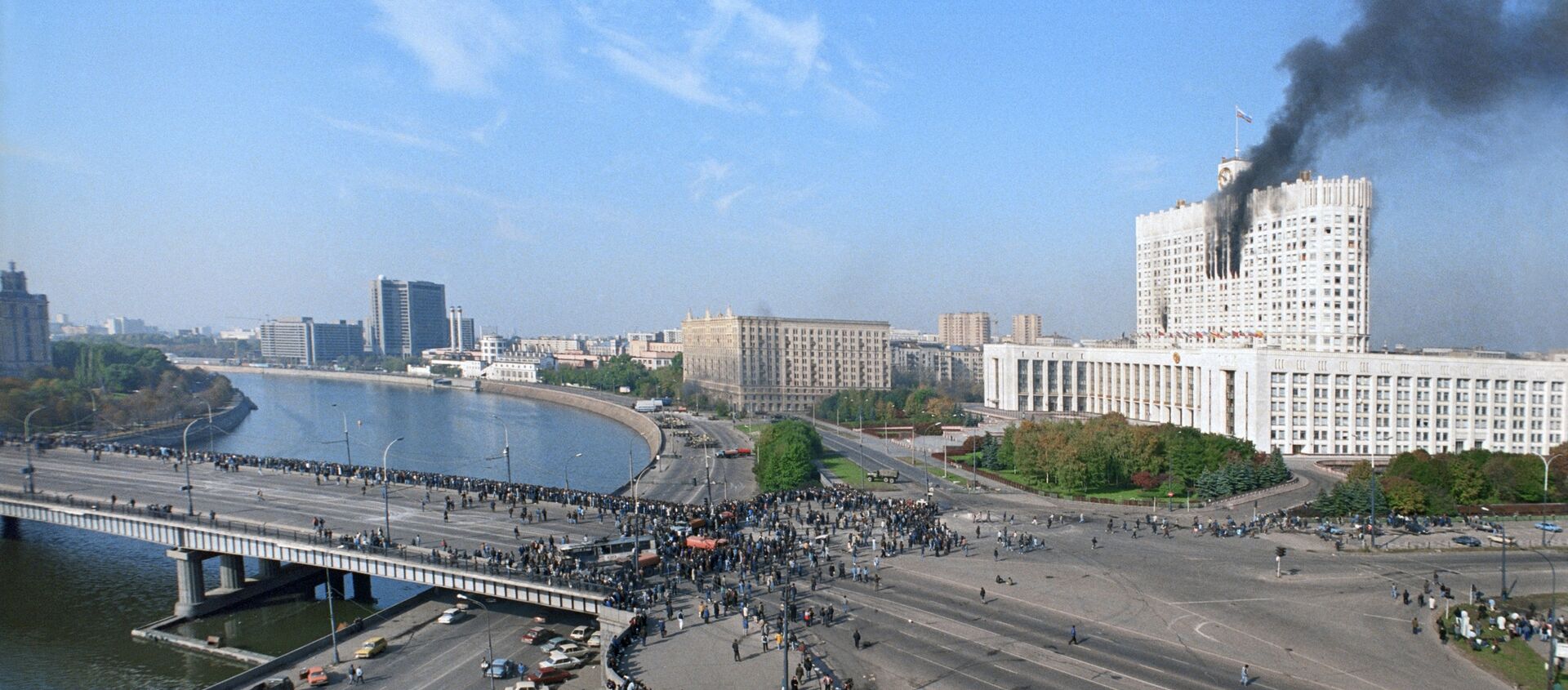
3 October 2018, 15:28 GMT
Yeltsin’s After Action Report to Clinton
On October 5, while the Supreme Soviet building was still smoldering, and the streets around it were cleaned of smashed barricades, rubble, wreckage and blood, the Russian and US presidents held a second telephone call, in which Clinton reiterated his close support for Yeltsin, and stressed that he had followed the events “closely.”
“Bill, thank you very much for your support, which I knew and felt would be coming. Now that these events are over, we have no more obstacles to Russia’s democratic elections and our transition to democracy and a market economy. The fascist organizations that had been active in these events have now been banned, so now I feel that all will be fine. It’s too bad that some people were killed, but this is the fault of those who were the first to open fire and acted in a provocative way,” Yeltsin said, pointing the finger squarely at the Supreme Soviet's defenders.
Yeltsin assured that he had restored full control over the situation, and that regional leaders, including those who had expressed support for Rutskoy, were “changing their support to us,” with the courts to decide what punishments to mete out to the rebellious lawmakers.
“I hope you’ll be able to get some rest now. I know it has been very hard for you, but you did everything exactly as you had to and I congratulate you for the way you handled it,” Clinton said, expressing eagerness over his planned visit to Moscow in January 1994. “Thank you for everything. I embrace you with all my heart,” Yeltsin replied.
Both before and immediately after the October crisis, the United States took advantage of Yeltsin’s domestic political weakness to flirt openly with the idea of NATO expansion toward Russia’s borders. Moscow’s efforts to cozy up to Washington toward formal “alliance” status were first rebuked by Clinton’s predecessor, George H.W. Bush, who
clarified in February 1992, just weeks after the Soviet collapse, that the Russian-US relationship would be one of “friendship,” not alliance.
“I cannot help but express our uneasiness as well over the fact that the discussion of how NATO might evolve is centering with increasing frequency on the scenario of quantitative expansion of the alliance by adding East European countries,” Yeltsin told Clinton in a letter delivered September 15, 1993, exactly a week before the constitutional crisis began.
“I tell you plainly that we favor a different approach, one that leads to a truly pan-European security system, an approach predicated on collective (but not on the basis of bloc membership) actions to prevent and resolve the crises and conflicts that now have Europe in turmoil. Security must be indivisible and must be based on pan-European structures,” Yeltsin added.
“The primary threat to Europe is now posed, not by confrontation between East and West but by a new generation of inter-ethnic conflicts. Quantitative expansion of NATO will hardly solve the problem of how to counteract these conflicts effectively. What needs to be done is to augment crisis prevention and peacemaking on a fully continental scale,” the Russian president argued.
Yeltsin also warned that while he personally did not see potential NATO expansion as an automatic indication of the alliance “turning against Russia,” it was “important to take into account how our public opinion might react to such a step. Not only the opposition, but moderate circles as well, would no doubt perceive this as a sort of neo-isolation of our country in diametric opposition to its natural admission into the Euro-Atlantic space,” he wrote.
In late October, several weeks after the Supreme Soviet's rebellion was routed, Clinton Secretary of State Warren Christopher visited Moscow to assuage Yeltsin’s concerns, assuring him that “the approach for future new membership in [NATO] was inclusive and non-discriminatory,”
and that the Partnership for Peace – a NATO initiative designed to ramp up diplomatic cooperation with countries in Eastern Europe and Scandinavia, would be an alternative to NATO expansion, not a precursor to it.
“This is genius!” a relieved Yeltsin exclaimed, saying the “brilliant idea” would ensure that Russia would not be treated like a “second-class citizen” but be “equal partners” with the West.
Christopher later
claimed that Yeltsin didn’t appear to understand him,
possibly because he was inebriated, and alleged that Yeltsin’s foreign minister, Andrei Kozyrev, failed to explain to the Russian president that the Partnership for Peace could indeed ultimately lead to NATO membership.
Weeks after the December 1993 elections, Clinton finally addressed the NATO expansion issue personally in a phone call with Yeltsin.
“Can I make one other point?” Clinton asked near the close of their long December 22, 1993 conversation after chewing the fat about elections, the new Russian parliamentary system, economic reforms and Western assistance. “Please do,” Yeltsin said.
“It’s about our foreign policy agenda. I will be in Brussels for the NATO Summit and in Prague before I see you and will want to discuss Russian participation in NATO’s Partnership for Peace proposal,” Clinton said.
“I also hope we can have a good discussion in restricted session of the many foreign policy issues, some close to your border, on our agenda. I especially want to discuss this because there is substantial concern in Europe and among your neighbors that the election will results will make Russia more aggressive and intrusive in their affairs,” Clinton noted, for the first time using an argument which has now become a standard NATO justification for the bloc’s expansion – so-called Russian “aggression.”
“I hope we can agree on cooperative efforts to dispel those fears…It will be important to allay concerns by producing concrete movement on Ukraine nuclear issues and also on the Baltics. I don’t know where you are on that, but I think it would be a good way to demonstrate the positive changes you have already brought to Russian foreign policy,” the US president said.
“We are open to this discussion,” Yeltsin responded. “We do not intend to interfere in the internal affairs of other countries. When I was in Brussels, I met with NATO Secretary General Woerner. We discussed a plan of action for the countries of Eastern Europe to cooperate with NATO in a way that would not be at the expense of Russia and also a plan of action for Russia to join NATO. So I fully agree with you and look forward to meeting with you,” Yeltsin said.
Clinton did not respond directly to Yeltsin’s point about possible Russian membership in the alliance, smoothly shifting the conversation to another topic.
In January 1994, before his visit to Moscow, Clinton met with leaders of the Czech Republic, Poland and Hungary, confirming that the Partnership for Peace program was simply a
“track that will lead to NATO membership.”
26 September 2021, 14:27 GMT
NATO Expansion 'Sows Seeds of Mistrust'
By the end of that year, finally fully cottoned on to Washington’s plans to incorporate Eastern Europe, but not Russia, into the bloc, Yeltsin asked Clinton point black at the Conference on Security and Cooperation in Europe summit in December 1994 why the US had chosen to sow “the seeds of mistrust.”
“Europe is in danger of plunging into a cold peace. History demonstrates that it is a dangerous illusion to suppose that the destinies of continents and the world community in general can somehow be managed from one single capital,” Yeltsin said.
He issued a similarly blunt warning in May 1995, when Vice President Al Gore was dispatched to Moscow for talks. “I see nothing but humiliation for Russia if you proceed [with NATO expansion, ed.]. How do you think it looks to us if one bloc continues to exist while the Warsaw Pact has been abolished?…Why do you want to do this? We need a new structure for Pan-European security, not old ones! But for me to agree to the borders of NATO expanding toward those of Russia – that would constitute a betrayal on my part of the Russian people,” Yeltsin said.
Yeltsin repeated his opposition to alliance expansion several times after that. Washington ignored the complaints, formally announcing plans to incorporate Poland, the Czech Republic and Hungary into NATO in 1997. The expansion, warned against by top US foreign policy minds, including containment doctrine guru George Kennan, laid the foundation for Russian-US distrust, ultimately culminating in the Ukrainian crisis and NATO’s proxy war against Russia using Kiev.
In April 2022 in a column in The Atlantic, Clinton retroactively attempted to whitewash his role in fomenting the conflict in Ukraine, claiming that throughout the 1990s and early 2000s, “we left the door open for Russia’s eventual membership in NATO.”
“The idea that we ignored, disrespected, or tried to isolate Russia is false. Yes, NATO expanded despite Russia’s objections, but expansion was about more than the US relationship with Russia,” Clinton wrote. The former president went on to cite Russia’s special military operation in Ukraine as “proof” that he made the right call, ignoring Washington's explicit commitment to Moscow not to expand "one inch east" of a reunified Germany in 1990.
NATO’s Expansionism: A Historic Inevitability?
Dr. Matthew Crosston, a professor of national security at Bowie State University, told Sputnik that unfortunately, the palpable positive “energy and excitement” experienced by many Russians and ordinary Americans after the end of the Cold War quickly took a back seat to plans by Washington policymakers to “maximize” as much as possible “the reality of what was considered the greatest historical victory ever achieved by the United States.”
“There was a very famous
article written around this time period by Francis Fukuyama, entitled ‘The End of History.’ Its main de facto premise was that the greatest ideological competition had concluded and democracy had won, thus signaling no other serious ideological competitions to be had. It was the end of history and the ultimate victor was American democracy. This wasn’t exactly what Fukuyama meant, of course. But it was the conclusion that Washington took from the article and lived with pretty much to this day. Certainly, that mentality dominated the entire 90s when it came to how the United States acted toward the ‘new’ Russian Federation: we won; you lost. From this point forward, your best path, Russia, is simply following the advice we offer you and do exactly as we tell you,” Dr. Crosston explained.
“Everyone can remember the ‘best buddies’ spirit that Clinton and Yeltsin always tried to create whenever they met. But underneath that spirit was still an adamant understanding by American power players that the path forward for Russia really should be not just advised by the United States but perhaps even actually designed and implemented for Russia. This concept – of no longer being enemies but not exactly being equal and independent allies either – has remained for the entire 30 years since that October coup and has always been a source of irritation, conflict, and interference between our two countries,” the academic said.
Yeltsin, Crosston believes, “clearly wanted the best for Russia and wanted to create a new relationship dynamic between the United States and his country,” but soon realized that “the US was not going to work with him to make it possible to craft a truly brand new and profoundly different relationship between the supposedly former rivals.” The former Russian president “truly believed if he open-heartedly embraced a cooperative relationship with America that the US would reciprocate and not take advantage. That belief was unfortunately somewhat naïve, and it was manipulated by some of his closest advisors within his own Kremlin team,” according to the observer.
Instead, Crosston stressed, the US embraced an “unofficial policy” of only engaging with Russia “in as much as it allows America to heavily influence policy choices and political decisions inside of the Kremlin, but not allow that engagement to bring about a real change in how Russia is viewed…America wanted a Russia that was friendly but pliable.”
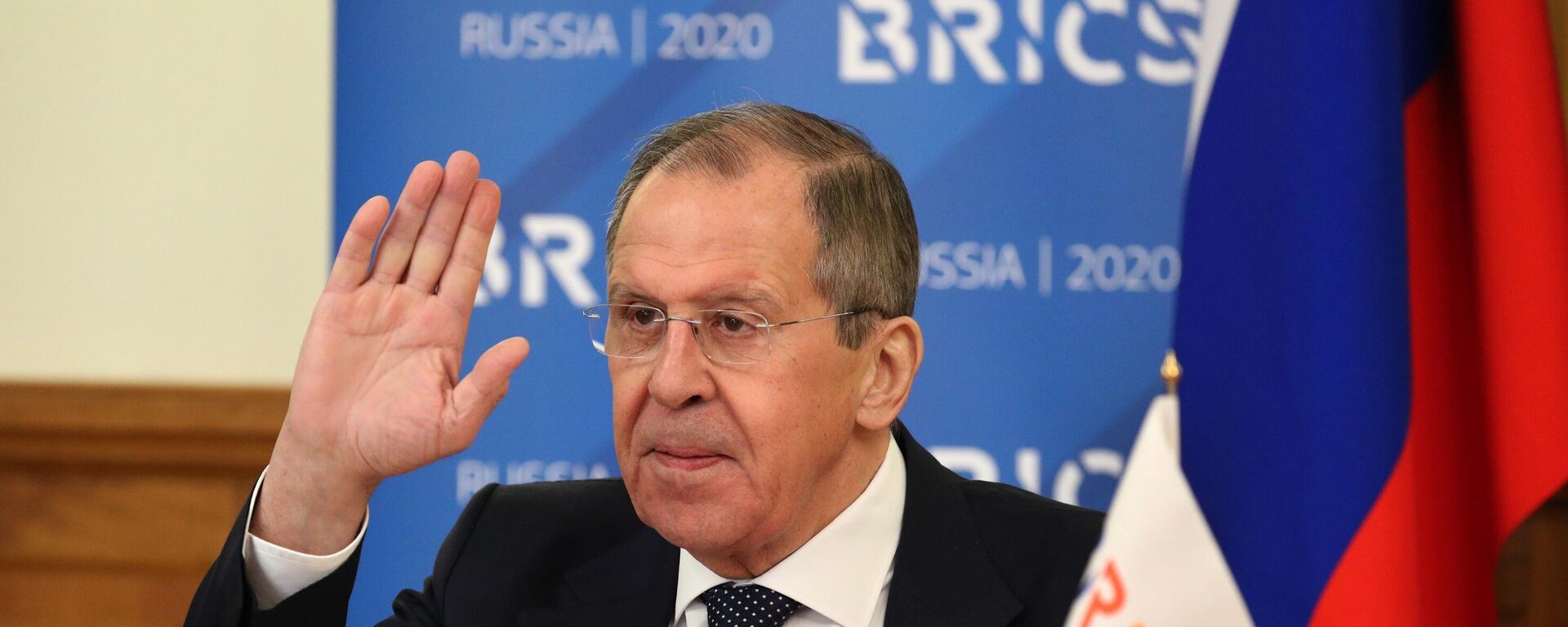
21 August 2023, 14:09 GMT
Ultimately, the academic emphasized that NATO’s prevailing doctrine after the Cold War revolved around the idea of “keeping Russia an enemy,” with the “old way of thinking” causing “the least disruption to existing institutional bureaucracies” in Washington.
“I have called it in my work a ‘Cold War pathology’ or a ‘Cold War residue’ and it became clear, first with Clinton but subsequently deepen[ing] with every president after him, that the American establishment was more comfortable with keeping Russia buried in that Cold War corner than trying to do the hard work of crafting a new relationship between the two rivals. To me, if the end of the Cold War is considered the greatest historical moment of the 20th century, then the failure to truly capitalize on that by creating a new American-Russian relationship is one of the biggest mistakes so far of the 21st century,” Crosston summed up.
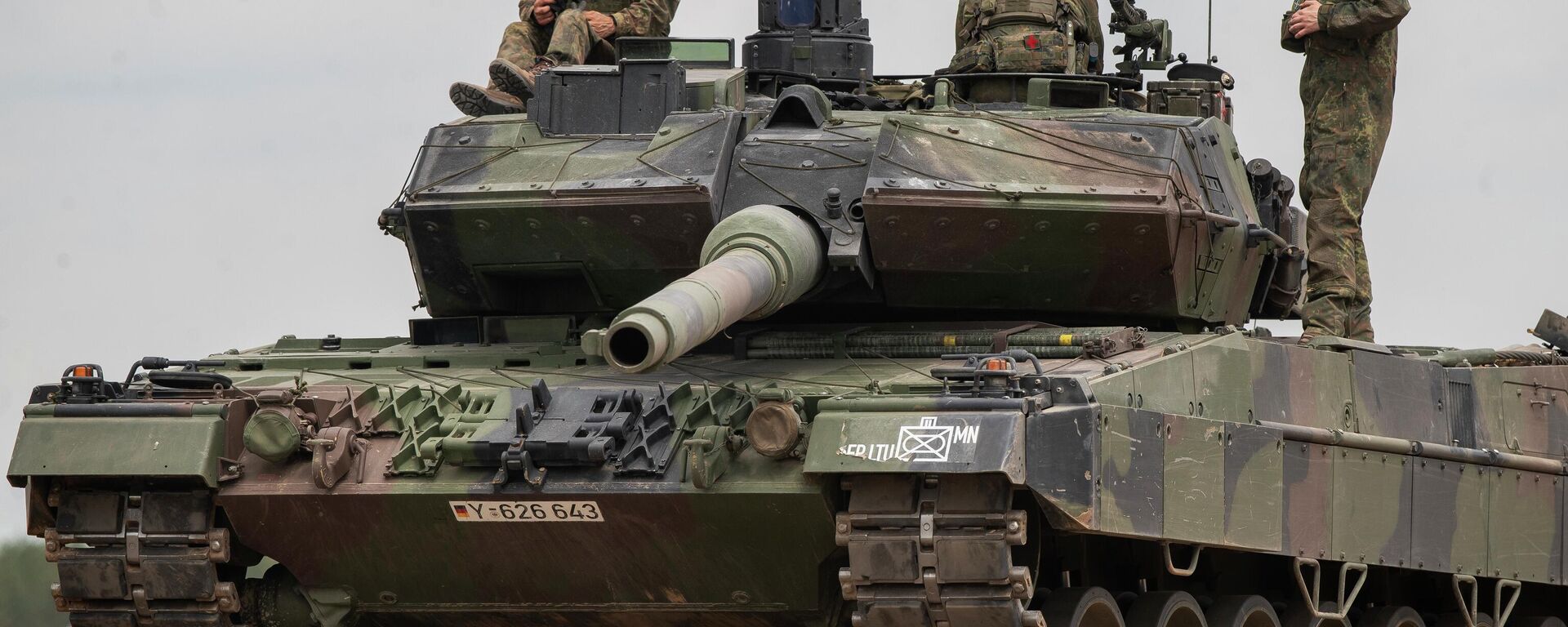
16 September 2023, 18:14 GMT

